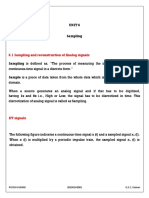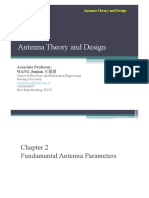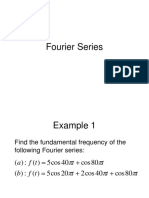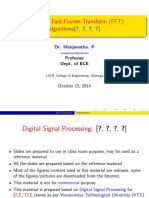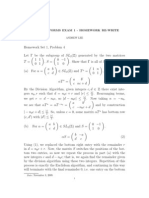Signals and Systems
Signals and Systems
Uploaded by
Mohammad Gulam AhamadCopyright:
Available Formats
Signals and Systems
Signals and Systems
Uploaded by
Mohammad Gulam AhamadOriginal Description:
Copyright
Available Formats
Share this document
Did you find this document useful?
Is this content inappropriate?
Copyright:
Available Formats
Signals and Systems
Signals and Systems
Uploaded by
Mohammad Gulam AhamadCopyright:
Available Formats
Signals and Systems
Lecture
Dr. Mohammed Gulam Ahamad
Salmanbin Abdulaziz Universiry
Signals and Systems 1
Lecture # 2
Introduction to Signals
EE 327 fall 2002
Signals:
1. Classification of Signals
1. Deterministic and Stochastic signals
2. Periodic and Aperiodic signals
3. Continuous time (CT) and Discrete time (DT)
4. Causal and anti-causal signals
5. Right and left sided signals
6. Bounded and unbounded signals
7. Even and odd signals
EE 327 fall 2002
Classification of Signals
1. Deterministic -
Predictive (An example is
sin wave, square wave)
2. Stochastic Non
predictive (An example is
noise signal or human voice)
EE 327 fall 2002
1. Periodic and Aperiodic Signals
Periodic signals have the property that
x(t+T)=x(t) for all t.
The smallest value of T satisfies the definition is
called the period.
Shown below are aperiodic signal (left) and a periodic signal (right).
EE 327 fall 2002
Classification of Signals
1. Periodic Signals
Simple
Complex
EE 327 fall 2002
Classification of Signals
1. Aperiodic
Impulse
Noise
EE 327 fall 2002
Classification of Signals
1. For both exponential CT ( ) and DT( )
signals, x is a complex quantity. To plot x, we can choose
to plot either its magnitude and angle or its real and
imaginary parts- whichever is more convenient for
analysis.
2. For example, suppose s= jt/8
3. and ,
4. then the real parts are:
}. 8 / cos{ } { )} ( {
}, 8 / cos{ } { )} ( {
8 /
8 /
n e n x
t e t x
n j
t j
t
t
t
t
= 9 = 9
= 9 = 9
8 /
t j
e z =
n
z n x = ) (
st
e t x = ) (
EE 327 fall 2002
Classification of Signals
1. Continuous-time (CT) and discrete time (DT)
signals
2. CT signals take on real or complex values as a function of an
independent variable that ranges over the real numbers and
are denoted as x(t).
3. DT signals take on real or complex values as a function of an
independent variable that ranges over the integers and are
denoted as x[n].
EE 327 fall 2002
Classification of Signals
1. For example, consider the image shown on the left and its DT
representation shown on the right.
The image on the left consists of 302 - 435 picture elements
(pixels) each of which is represented by a triplet of numbers
{R,G,B} that encode the color. Thus, the signal is represented
by c[n,m] where m and n are the independent variables that
specify pixel location and c is a color vector specified by a
triplet of hues {R,G,B} (red, green, and blue).
EE 327 fall 2002
Classification of Signals
1. Real and complex signals
2. Signals can be real, imaginary, or complex.
3. An important class of signals are the complex exponentials:
4. - the CT signal where s is a complex number,
5. - the DT signal where z is a complex number.
6. Q. Why do we deal with complex signals?
7. A. They are often analytically simpler to deal with than real
signals.
st
e t x = ) (
n
z n x = ) (
EE 327 fall 2002
Classification of Signals
1. Causal and anti-causal signals
2. A causal signal is zero for t < 0 and
3. anti- causal signal is zero for t > 0.
EE 327 fall 2002
Classification of Signals
1. Right- and left-sided signal
2. A right-sided signal is zero for t < T and a left-
sided signal is zero for t > T where T can be
positive or negative.
EE 327 fall 2002
Classification of Signals
1. Bounded and unbounded
signals
EE 327 fall 2002
Classification of Signals
1. Even and odd signals
2. Even signals xe(t) and odd signals xo(t) are defined as
xe(t) = xe(-t) and xo(t) = - xo(-t)
EE 327 fall 2002
Classification of Signals
1. Any signal is a sum of unique odd and even signal.
Using
2. x(t) = xe(t) + xo(t) and x(-t) = xe(t) - xo(t)
Yields and
)) ( ) ( (
2
1
) ( t x t x t x
o
=
)) ( ) ( (
2
1
) ( t x t x t x
e
+ =
EE 327 fall 2002
Classification of Signals
Measuring Signals
1. Measure Amplitude
peak to peak amplitude
mean amplitude (r.m.s.)
2. Measure Period and Repetition
Frequency
duration of 1 cycle (s)
number of cycles per second (Hz)
3. How to measure shape?
EE 327 fall 2002
Signal Analysis
1. Simple Periodic Signals
called sinusoidal signals
only need to know 3 things:
period (or frequency), amplitude & phase
EE 327 fall 2002
Representation of signals
Building-block signals;
1. We will represent signal as sums of
building-block signals.
2. Important families of building-block
signals are the eternal (everlasting ),
complex exponentials and the unit
impulse functions.
EE 327 fall 2002
Building-block signals;
1. Eternal, complex exponentials
2. These signal have the form
3. for all t and for all n,
where X, s, and z are complex numbers.
4. In general s is complex and can be written
as s = o + je,
5. where o and e are the real and
imaginary parts of s.
st
Xe t x = ) (
EE 327 fall 2002
n
Xz n x = ) (
Building-block signals;
1. Eternal, complex exponentials- real s
2. If s = o is real and X is real then
3. ,
4. And we get the family of real exponential functions.
5. Eternal, complex exponentials- imaginary s
6. If s = je is imaginary and X is real then
7.
8.
9. and we get the family of sinusoidal functions.
t
Xe t x
o
= ) (
EE 327 fall 2002
), sin (cos ) ( t j t X Xe t x
t j
e e
e
+ = =
Building-block signals;
1. Eternal, complex exponentials- complex s
2. If s = o + je is complex and X is real
then
3. And we get the family of damped
sinusoidal functions.
EE 327 fall 2002
), sin (cos ) (
) (
t j t Xe Xe t x
t t j
e e
o e o
+ = =
+
Building-block signals;
1. For is
plotted for different values of s superimposed on
the complex s-plane.
t Xe t x Xe t x
t t s
e
o
cos )} ( { , ) ( = 9 =
EE 327 fall 2002
Building-block signals;
1. For is plotted
for different values of s superimposed on the
complex s-plane.
EE 327 fall 2002
t Xe t x Xe t x
t t s
e
o
sin )} ( { , ) ( = 9 =
Eternal complex exponentials- why are they
important?
1. Almost any signal of practical interest can be
represented as a superposition (sum) of eternal
complex exponentials.
2. The output of a linear, time-invariant (LTI)
system (to be defined next time) is simple to
compute if the input is a sum of eternal
complex exponentials.
3. Eternal complex exponentials are the
eigenfuntions of characteristic (unforced,
homogeneous) responses of LTI systems.
EE 327 fall 2002
Building block signals Unit impulse definition
1. The unit impulse o(t), is an important signal of CT systems. The Dirac delta function,
is not a function in the ordinary sense. It is defined by the integral relation
And is called a generalized function.
1. The unit impulse is not defined in terms of its values, but is defined by how it acts
inside an integral when multiplied by a smooth function f(t). To see that the area of
the unit impulse is 1, choose f(t) = 1 in the definition. We represent the unit impulse
schematically as shown below; the number next to the impulse is its area.
. ) ( ) ( ) ( dt t f t f t o t =
}
EE 327 fall 2002
). ( ) ( ) ( ) 0 ( t d t f f o t
}
=
Unit impulse- narrow pulse approximation
1. To obtain an intuitive feeling for the unit impulse, it is often
helpful to imagine a set of rectangular pulses where each
pulse has width c and height 1/c so that its area is 1.
The unit impulse is the quintessential tall and narrow pulse!
EE 327 fall 2002
Unit impulse- intuiting the definition
1. To obtain some intuition about the meaning of the
integral definition of the impulse, we will use a tall
rectangular pulse of unit area as an approximation to
the unit impulse.
2. As the rectangular pulse gets taller and narrower,
) 0 (
) 0 (
) ( ) ( lim
0
f
f
dt t t f = -
}
c
c
c c
EE 327 fall 2002
Unit impulse- the shape does not matter
1. There is nothing special about the rectangular
pulse approximation to the unit impulse. A
triangular pulse approximation is just as good.
As far as out definition is concerned both the
rectangular and triangular pulse are equally good
approximations. Both act as impulses.
EE 327 fall 2002
Unit impulse- the values do not matter
1. The values of the approximation functions do not matter either. The
function on the left has unit area and takes on the arbitrary value A
for t=0. The function on the right, which we shall encounter
frequently in later lectures, has the property that it has non-zero
values at most of its values, all but a countably infinite number of
points, nut still acts as a unit impulse
What all these approximations have in common is that as c gets small the area of
each function occupies an increasingly narrow time interval centered on t=0.
EE 327 fall 2002
You might also like
- Lecture 1. Digital Signal Processing - BasicsDocument19 pagesLecture 1. Digital Signal Processing - BasicsDiu ThanhNo ratings yet
- Fundamentals of Digital Quadrature ModulationDocument5 pagesFundamentals of Digital Quadrature Modulationslumber12100% (1)
- ME4213 Tutorial 2aDocument4 pagesME4213 Tutorial 2aLinShaodun100% (1)
- A Naidu Book Chapter0 FrontPages 2017-03-12Document23 pagesA Naidu Book Chapter0 FrontPages 2017-03-12PraveenNambisanNo ratings yet
- Signals & SystemsDocument49 pagesSignals & Systemssq11fpNo ratings yet
- Signal Spectra, Signal ProcessingDocument16 pagesSignal Spectra, Signal ProcessingJc Bernabe Daza100% (1)
- Effect of Noise in Analog Communication SystemsDocument64 pagesEffect of Noise in Analog Communication SystemsAnet Augustin100% (2)
- Analog Modulation TechniquesDocument66 pagesAnalog Modulation Techniquespawan33% (3)
- Noise in Communication SystemsDocument35 pagesNoise in Communication SystemsGoitom HaileNo ratings yet
- Amplitude Modulation Chap 2Document51 pagesAmplitude Modulation Chap 2Allyna Calixtro100% (1)
- Z TransformDocument59 pagesZ Transformtemkimleang100% (1)
- 6.1 Sampling and Reconstruction of Analog Signals: Piyush Kumar 20104148901 G.E.C, KaimurDocument9 pages6.1 Sampling and Reconstruction of Analog Signals: Piyush Kumar 20104148901 G.E.C, KaimurEr VishuuuNo ratings yet
- PLL Intro 594a s05Document46 pagesPLL Intro 594a s05jaberyemeni100% (1)
- Assignment 1Document5 pagesAssignment 1Saarthi Sood100% (1)
- Wave Shaping and Swiching CircuitsDocument3 pagesWave Shaping and Swiching Circuitskaran007_m100% (2)
- Exam 1Document108 pagesExam 1ManikaushikNo ratings yet
- DBM, DBW, DBVDocument7 pagesDBM, DBW, DBVsaid shayden100% (1)
- 3 - CMOS InverterDocument32 pages3 - CMOS Inverterroxy8marie8chanNo ratings yet
- Digital Signal Processing Lecture Notes - 22nov2010 - v4Document11 pagesDigital Signal Processing Lecture Notes - 22nov2010 - v4Thiagu RajivNo ratings yet
- Bipolar Junction Transistors Part 1Document36 pagesBipolar Junction Transistors Part 1Micah Paña100% (1)
- Presentation On RF MixersDocument33 pagesPresentation On RF MixersZeeshan Akhtar100% (1)
- Wireless Communication Multiple Access TechniqueDocument76 pagesWireless Communication Multiple Access TechniqueLeow100% (1)
- FM DelieveredDocument46 pagesFM DelieveredFaizan Ashraf100% (2)
- Sampling and Baseband ModulationDocument65 pagesSampling and Baseband ModulationAbdul Qawi Ansari100% (1)
- Pulse Amplitude ModulationDocument86 pagesPulse Amplitude ModulationPraful Jagtap100% (1)
- Chap1 1 Nonlinearity and NoiseDocument46 pagesChap1 1 Nonlinearity and NoiseLong Lê VănNo ratings yet
- Chapter 2 - Part 1-Amplitude Modulation - v2Document50 pagesChapter 2 - Part 1-Amplitude Modulation - v2Vijay Papi Reddy Allam100% (1)
- Pulse ModulationDocument12 pagesPulse Modulationhlrw100% (1)
- Angle Modulation Includes The Following Types of ModulationDocument7 pagesAngle Modulation Includes The Following Types of Modulationshankar100% (1)
- Introduction To Communication SystemsDocument19 pagesIntroduction To Communication SystemsSolomon Tadesse AthlawNo ratings yet
- Digital Modulation 2. Digital Transmission 3. Multiple Access MethodsDocument39 pagesDigital Modulation 2. Digital Transmission 3. Multiple Access MethodsFarah Arya100% (1)
- Microwave Phase Shifters and AttenuatorsDocument3 pagesMicrowave Phase Shifters and AttenuatorsBruno AlvimNo ratings yet
- Discrete - Time System and AnalysisDocument113 pagesDiscrete - Time System and Analysisapaijas0% (2)
- Stick Diagrams and LayoutsDocument17 pagesStick Diagrams and LayoutsPraneetha InumarthiNo ratings yet
- Z TransformDocument1 pageZ TransformmultisporkyNo ratings yet
- Lectrure 2.basic Antenna ParametersDocument60 pagesLectrure 2.basic Antenna ParametersR Gowri ManohariNo ratings yet
- 2-Lecture Notes Lesson4 4Document10 pages2-Lecture Notes Lesson4 4kstu1112No ratings yet
- Chapter 2 RF Microwave FiltersDocument118 pagesChapter 2 RF Microwave FiltersbadhanalmominulhaqueNo ratings yet
- Signals, Spectra, Signal Processing IntroDocument5 pagesSignals, Spectra, Signal Processing IntroJun JunNo ratings yet
- Electromagnetic WavesDocument5 pagesElectromagnetic WavesVishwanath BrungiNo ratings yet
- 5 - Optimum Receivers For The AWGN Channel - Test - MODIFIED PDFDocument45 pages5 - Optimum Receivers For The AWGN Channel - Test - MODIFIED PDFajayroy12No ratings yet
- Chapter13 Transceiver Design ExampleDocument72 pagesChapter13 Transceiver Design ExampleFernando Martinez100% (1)
- Block Diagram Representation2Document74 pagesBlock Diagram Representation2Chernet TugeNo ratings yet
- Fourier Series PresentationDocument81 pagesFourier Series PresentationRajithNimali100% (2)
- Noise and InterferenceDocument49 pagesNoise and InterferenceDhananjay ThakurNo ratings yet
- Modulacion-Demodulacion-Medios de Transmision y NormatividadDocument5 pagesModulacion-Demodulacion-Medios de Transmision y NormatividadOziel RivasNo ratings yet
- Mixer 1Document59 pagesMixer 1bayman66100% (1)
- 4) Frequency and Phase ModulationDocument13 pages4) Frequency and Phase ModulationAditya PaulNo ratings yet
- Fourier Series Problems and SolutionDocument78 pagesFourier Series Problems and SolutionGellie Buenaventura100% (1)
- RF Mixers: RF Mixers Are 3-Port Active or Passive Devices. They Are Designed To Yield Both, ADocument13 pagesRF Mixers: RF Mixers Are 3-Port Active or Passive Devices. They Are Designed To Yield Both, ARiho Reinhold100% (2)
- Third Order Intercept PointDocument3 pagesThird Order Intercept PointRaj MalhotraNo ratings yet
- Quadrature Amplitude Modulation (QAM) ReceiverDocument12 pagesQuadrature Amplitude Modulation (QAM) ReceiverAhmed HamoudaNo ratings yet
- Analog CommunicationDocument6 pagesAnalog CommunicationSriramNo ratings yet
- Radio Receiver SuperheterodyneDocument15 pagesRadio Receiver SuperheterodyneSyieda Zamry100% (2)
- Princom Fundamentals of Frequency ModulationDocument5 pagesPrincom Fundamentals of Frequency Modulationmelwin victoriaNo ratings yet
- 05 - LTI SystemsDocument23 pages05 - LTI SystemsdemononesNo ratings yet
- Chapter 4 Power AmplifierDocument15 pagesChapter 4 Power Amplifierpaancute8982No ratings yet
- Transceiver ArchitecturesDocument23 pagesTransceiver ArchitecturesEnricoLia100% (1)
- UNIT - 3: Fast-Fourier-Transform (FFT) Algorithms: Dr. Manjunatha. PDocument100 pagesUNIT - 3: Fast-Fourier-Transform (FFT) Algorithms: Dr. Manjunatha. PMVRajeshMaliyeckalNo ratings yet
- H-Tutorial Impedance MatchingDocument24 pagesH-Tutorial Impedance Matchingngt881100% (1)
- Signals Are Variables That Carry Information - Systems Process Input Signals To Produce Output SignalsDocument10 pagesSignals Are Variables That Carry Information - Systems Process Input Signals To Produce Output Signalsking_hhhNo ratings yet
- Control Systems1Document19 pagesControl Systems1Mohammad Gulam AhamadNo ratings yet
- Control Systems1Document19 pagesControl Systems1Mohammad Gulam AhamadNo ratings yet
- Donors and Acceptors in SemiconductorsDocument28 pagesDonors and Acceptors in SemiconductorsMohammad Gulam AhamadNo ratings yet
- Distributed Systems Architectures: Architectural Design For Software That Executes On More Than One ProcessorDocument44 pagesDistributed Systems Architectures: Architectural Design For Software That Executes On More Than One ProcessorMohammad Gulam AhamadNo ratings yet
- Client Server and ProtocolsDocument18 pagesClient Server and ProtocolsMohammad Gulam AhamadNo ratings yet
- Examples OfzTransformDocument17 pagesExamples OfzTransformMohammad Gulam Ahamad100% (1)
- IntrotocomputerDocument16 pagesIntrotocomputerMohammad Gulam AhamadNo ratings yet
- m6 GameDocument21 pagesm6 GameMohammad Gulam AhamadNo ratings yet
- AIDocument9 pagesAIMohammad Gulam AhamadNo ratings yet
- Application of Image Enhancement Techniques To Magnetic Resonance ImagingDocument14 pagesApplication of Image Enhancement Techniques To Magnetic Resonance ImagingMohammad Gulam AhamadNo ratings yet
- PIC MicrocontrollersDocument20 pagesPIC MicrocontrollersMohammad Gulam Ahamad67% (3)
- Data Structures-TreesDocument40 pagesData Structures-TreesMohammad Gulam Ahamad100% (3)
- MPC555Document27 pagesMPC555Mohammad Gulam AhamadNo ratings yet
- Dr. Mohammed Gulam AhamadDocument37 pagesDr. Mohammed Gulam AhamadMohammad Gulam AhamadNo ratings yet
- MPC555 IoDocument24 pagesMPC555 IoMohammad Gulam AhamadNo ratings yet
- Continuity 1401 XDocument16 pagesContinuity 1401 XAnonymous CKg2M9SnNo ratings yet
- Original Scientific Paper: 2 Croatian Congress On Geomathematics and Geological Terminology, 2018Document12 pagesOriginal Scientific Paper: 2 Croatian Congress On Geomathematics and Geological Terminology, 2018Mohaimen-Ul AzamNo ratings yet
- Trigonometric EquationDocument23 pagesTrigonometric EquationPokala KrishnavamshiNo ratings yet
- Chap23 - 380-391Document12 pagesChap23 - 380-391jfarrell_ie5767No ratings yet
- Arithmetic Sequence PDFDocument11 pagesArithmetic Sequence PDFAngelo AcenasNo ratings yet
- Inequalities MuirheadDocument4 pagesInequalities MuirheadAyush AryanNo ratings yet
- A. Explain The Terms: Pure Strategy, Mixed Strategy, Saddle Point, Competitive Games, Payoff Matrix, Rectangular Games. Pure StrategyDocument3 pagesA. Explain The Terms: Pure Strategy, Mixed Strategy, Saddle Point, Competitive Games, Payoff Matrix, Rectangular Games. Pure StrategyChintan PatelNo ratings yet
- Discrete Structures Exam 3Document4 pagesDiscrete Structures Exam 3Dave JamesNo ratings yet
- 06 ESm 43 MQDocument6 pages06 ESm 43 MQGuruprasadNo ratings yet
- Euler MethodDocument2 pagesEuler MethodTahreem TahoorNo ratings yet
- (Graduate Studies in Mathematics 178.) Clelland, Jeanne N. - From Frenet To Cartan - The Method of Moving Frames-American Mathematical Society (2017)Document433 pages(Graduate Studies in Mathematics 178.) Clelland, Jeanne N. - From Frenet To Cartan - The Method of Moving Frames-American Mathematical Society (2017)Luis Gustavo de AlmeidaNo ratings yet
- Operations Research - MTH601 Fall 2005 Final Term Paper Session 6Document4 pagesOperations Research - MTH601 Fall 2005 Final Term Paper Session 6SuccessNo ratings yet
- Anthony Vaccaro MATH 264 Winter 2023 Assignment Assignment 10 Due 04/09/2023 at 11:59pm EDTDocument2 pagesAnthony Vaccaro MATH 264 Winter 2023 Assignment Assignment 10 Due 04/09/2023 at 11:59pm EDTAnthony VaccaroNo ratings yet
- Barth VKI95Document141 pagesBarth VKI95Jose UlloaNo ratings yet
- A Comparison of Three Iterative Methods Fo Solution Linear Equation PDFDocument3 pagesA Comparison of Three Iterative Methods Fo Solution Linear Equation PDFIrwan RahmanNo ratings yet
- Problem Sheet 3Document2 pagesProblem Sheet 3mohammedNo ratings yet
- Modular Forms Exam - Homework RewriteDocument2 pagesModular Forms Exam - Homework RewritejhqwhgadsNo ratings yet
- M.A. - M.Sc. Mathematics - 1st Semester - Home Assignment - 2023Document2 pagesM.A. - M.Sc. Mathematics - 1st Semester - Home Assignment - 2023Bijit BaruahNo ratings yet
- Solving Goal Programming Model Using POMDocument59 pagesSolving Goal Programming Model Using POMbonski3155No ratings yet
- Hercor College High SchoolDocument3 pagesHercor College High SchoolChristian Dave BalasaNo ratings yet
- 187HW2 2008Document2 pages187HW2 2008rahaaa_jooonNo ratings yet
- State Space Solutions and Realizations: EE-601: Linear System TheoryDocument29 pagesState Space Solutions and Realizations: EE-601: Linear System TheorysunilsahadevanNo ratings yet
- 000250Document70 pages000250Katz EscañoNo ratings yet
- Conic Sections: Prepared By: Roqui Mabugay GonzagaDocument30 pagesConic Sections: Prepared By: Roqui Mabugay GonzagaRoqui M. GonzagaNo ratings yet
- NCERT Solutions For Class 11 Maths Chapter 2 Relations and FunctionsDocument15 pagesNCERT Solutions For Class 11 Maths Chapter 2 Relations and FunctionsSk SharmaNo ratings yet
- 07 CST ElementsDocument1 page07 CST ElementssimalaraviNo ratings yet
- 9 PDFDocument11 pages9 PDFKathMae BoaNo ratings yet
- Group Assignment MarksDocument22 pagesGroup Assignment Marks翁绍棠No ratings yet











